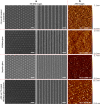Postdeposition UV-Ozone Treatment: An Enabling Technique to Enhance the Direct Adhesion of Gold Thin Films to Oxidized Silicon
- PMID: 31189059
- PMCID: PMC6595434
- DOI: 10.1021/acsnano.9b01403
Postdeposition UV-Ozone Treatment: An Enabling Technique to Enhance the Direct Adhesion of Gold Thin Films to Oxidized Silicon
Abstract
We found that continuous films of gold (Au) on oxidized silicon (SiO2) substrates, upon treatment with ultraviolet (UV)-ozone, exhibit strong adhesion to the SiO2 support. Importantly, the enhancement is independent of micro- or nanostructuring of such nanometer-thick films. Deposition of a second Au layer on top of the pretreated Au layer makes the adhesion stable for at least 5 months in environmental air. Using this treatment method enables us to large-scale fabricate various SiO2-supported Au structures at various thicknesses with dimensions spanning from a few hundreds of nanometers to a few micrometers, without the use of additional adhesion layers. We explain the observed adhesion improvement as polarization-induced increased strength of Auδ-Siδ+ bonds at the Au-SiO2 interface due to the formation of a gold oxide monolayer on the Au surface by the UV-ozone treatment. Our simple and enabling method thus provides opportunities for patterning Au micro/nanostructures on SiO2 substrates without an intermediate metallic adhesion layer, which is critical for biosensing and nanophotonic applications.
Keywords: UV-ozone treatment; adhesion enhancement; gold oxide; gold thin films; oxidized silicon substrates.
Conflict of interest statement
The authors declare no competing financial interest.
Figures







Similar articles
-
Nanometer-Thick Gold on Silicon as a Proxy for Single-Crystal Gold for the Electrodeposition of Epitaxial Cuprous Oxide Thin Films.ACS Appl Mater Interfaces. 2016 Jun 22;8(24):15828-37. doi: 10.1021/acsami.6b04552. Epub 2016 Jun 7. ACS Appl Mater Interfaces. 2016. PMID: 27232100
-
Silk protein as a new optically transparent adhesion layer for an ultra-smooth sub-10 nm gold layer.Nanotechnology. 2017 Mar 17;28(11):115201. doi: 10.1088/1361-6528/aa5aaa. Epub 2017 Jan 19. Nanotechnology. 2017. PMID: 28102832
-
Influence of Ti and Cr Adhesion Layers on Ultrathin Au Films.ACS Appl Mater Interfaces. 2017 Oct 25;9(42):37374-37385. doi: 10.1021/acsami.7b10136. Epub 2017 Oct 11. ACS Appl Mater Interfaces. 2017. PMID: 28967257
-
Adhesion layer-free attachment of gold on silicon wafer and its application in localized surface plasmon resonance-based biosensing.Sens Actuators A Phys. 2020 Sep 1;312:112155. doi: 10.1016/j.sna.2020.112155. Epub 2020 Jun 10. Sens Actuators A Phys. 2020. PMID: 32647405 Free PMC article.
-
Nanostructures Stacked on Hafnium Oxide Films Interfacing Graphene and Silicon Oxide Layers as Resistive Switching Media.Nanomaterials (Basel). 2023 Apr 9;13(8):1323. doi: 10.3390/nano13081323. Nanomaterials (Basel). 2023. PMID: 37110908 Free PMC article.
Cited by
-
Wrinkled Interfaces: Taking Advantage of Anisotropic Wrinkling to Periodically Pattern Polymer Surfaces.Adv Sci (Weinh). 2023 Apr;10(12):e2207210. doi: 10.1002/advs.202207210. Epub 2023 Feb 12. Adv Sci (Weinh). 2023. PMID: 36775851 Free PMC article. Review.
-
State of the art of ultra-thin gold layers: formation fundamentals and applications.Nanoscale Adv. 2022 Mar 25;4(12):2533-2560. doi: 10.1039/d2na00127f. eCollection 2022 Jun 14. Nanoscale Adv. 2022. PMID: 36132287 Free PMC article. Review.
-
UV Irradiation of Wood Surface: Bonding Properties.Polymers (Basel). 2023 May 31;15(11):2552. doi: 10.3390/polym15112552. Polymers (Basel). 2023. PMID: 37299351 Free PMC article.
-
Controlled synthesis of gold nanorod dimers with end-to-end configurations.RSC Adv. 2022 May 5;12(21):13464-13471. doi: 10.1039/d2ra01288j. eCollection 2022 Apr 28. RSC Adv. 2022. PMID: 35527728 Free PMC article.
-
A Plasmonic Nanoledge Array Sensor for Selective Detection of Cardiovascular Disease Biomarkers in Human Whole Blood.ACS Appl Nano Mater. 2024 Aug 16;7(17):20024-20033. doi: 10.1021/acsanm.4c02524. eCollection 2024 Sep 13. ACS Appl Nano Mater. 2024. PMID: 39296866 Free PMC article.
References
LinkOut - more resources
Full Text Sources

